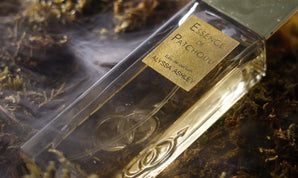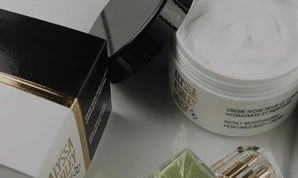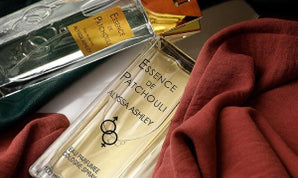The world of perfumery, as I have said many times, is magical. Its magic resides in different factors: first of all, the strong mnemonic significance smell has in our lives; secondly, the imaginative power it conveys, allowing our minds not only to travel back in time but also to shape concepts, objects and most of all feelings.
This unbreakable link between smell and memory is central to my ongoing research, the ability of its products to “express something” (whatever it may be, with no distinction) classifies perfumery as a true art, precisely for this ability defined as “emotional”. The emotion one feels when admiring a work of art can be equal to that which is felt when remembering it.
By now the connections between smell and memory, between the nose and the brain, are common knowledge, so much so that even in the perfume industry many scents (not only for the body, but also for the home or laundry, for example) are given the name of the concept they want to express. So in recent years we have witnessed perfumes called “Walk on the Beach”, “Trip out of Town” or “Magical Christmas”. What is the most surprising thing about this? That by smelling these perfumes we will truly think about walks at sunset or Christmas holidays with our families! How is this possible? Christmas has no smell, and neither does the sunset, or a fieldtrip... this is where our brain comes along, working closely with the nose, giving us hyper-sensory feelings.
How do we perceive smell
Finding a final and definitive answer to this question would be great, but sadly the realm of smell is magical for this reason too: it is still very mysterious. We may often think that science can give us conclusive explanations for all doubts or events, yet something so simple as the ability to smell reveals some gray areas, and this shows it is not “simply” a question of smelling. What is certain, though, is that science is advancing in this area and that the ancient theory Theophrastus exposed in his treaty On Smells, has changed and evolved many times and continually, leading to the most recent hypotheses and discoveries.
The nose, the main organ involved in smelling, is often seen as a “window to the world”, or as our brain’s opening to the world. The sense of smell is often defined as proximal, as it allows us to perceive both close and internal parts of this world (smells), but also distal as it also draws our attention to objects that are distant and out of the reach of our other senses (this is what makes it fundamental for survival).
As we have said, our nose and sense of smell work together in receiving and decoding smells, but how? Three steps have been identified, but we know that the impulse (excluding external complications) reaches the brain immediately.
- The first step starts in the olfactory epithelium, located indicatively close behind the nostrils and above the palate. This is where some truly specialised neurons called olfactory receptors are. The odorous molecules which make up smells (which are therefore a composite of them) are captured by the receptors, shaped like holes, which only manage to capture the compatible molecules in a type of relationship scientists, to make the concept clearer, call “lock-and-key”. Luckily, human beings are born with about 10 million olfactory neurons, divided into about 400 types according to the receptors they can intercept, but we should clarify that some of them work as a master key and can connect with more than one molecule.
- Once the molecules have been “filtered”, they reach the olfactory bulb, just above the epithelium, to be sorted. Then the codes are transmitted and only need to be decoded as a unambiguous message.
- Obviously the brain, in the olfactory cortex, deals with the code and identification. The mitral cells send the information to the amygdala and the hippocampus, which are responsible for controlling emotions and memory respectively. The brain’s decoding will identify the smell. This is why the sense of smell is that which is most connected with emotions and memories, and this is why naming a perfume “Magical Christmas” does make sense, because it plays on cultural and personal factors, but at the same time on processes and associations that are universal.
Through this process the scent has reached our brains, it has been labelled and stored in memories, but how is it interpreted? People have for a long time asked themselves whether there is a “dictionary” of smells, how they are classified (as early as the Third Century B.C. Plato and later Theophrastus had tried to answer these questions) and appraised. As for the latter, the answer resides in purely cultural factors for the individual and their community’s traditions. Very simply, some smells are considered “bad” (it is even hard to define this, if we reflect upon it) or “good”, others as “feminine”, or “sensual” by one community, while they may be considered the opposite by another. The most common example is the rose, in Europe it is generally associated with femininity, but it is used by males too in the Arab culture.
Once the molecules are captured, our brain’s label is definitely “rose flower”. As the impulses are sent at the same time to the memory (hippocampus) and the amygdala (emotion), our brain probably makes a comparison between the perfume of a rose and the memories related to it. We might recall the perfume worn by our mother or sister, or the image of a rose, often associated with female beauty products, and so on. The association will therefore be immediate: rose=feminine.
Let us now try thinking of an exotic fruit which is far from our culture and that we have never smelled. If presented to our sense of smell, we will classify it maybe as intense or less intense, pungent or fresh, we might even say it is good. Yet, that fruit is used by some tribes in the Amazon to cover burials, and is by those tribes considered an unpleasant smell, which they would never use to perfume the body, while we have classified it as a “good fruity smell” we would love to choose for our body butter.
Recent discoveries in the field of olfaction
A lot has been discovered and a lot has yet to be discovered! As we said, the sense of smell is fundamental for human survival, it gained importance recently when the loss of smell (in technical terms anosmia) was isolated as one of the possible symptoms of the Covid-19 virus. However, the importance of smell has for centuries been undisputed, even though, as we have many times underlined, it is often neglected in favour of the unquestionable queen of senses: sight.
A research group from the Centre for Neuroscience and Cognitive Science of Rovereto in collaboration with NYU has conducted a study on the perception of smell, the result of which was revolutionary: they managed to transmit a perfume to the brain, without passing through the nostrils.
An artificial smell was in fact transmitted directly to the nervous cells of the olfactory bulb, the sorting area, thus bypassing the olfactory epithelium. Their research has been going on for years, during which individuals have been exposed to different scents, to make a note of which neurons are activated for each of them and in which order this occurs.
The study shows for the first time how the brain combines different groups of neurons positioned in different parts of it and how it organises them and activates them in a temporal sequence, just as the written alphabet combines different letters in a temporal sequence to generate the meaning of a sentence. In this case it happens for a perfume.
The study was not abandoned after these first few results and will keep looking for more certain answers, hoping to be able to give those who are affected by pathologies of the olfactory system the enormous pleasures of scents, whichever these may be.









